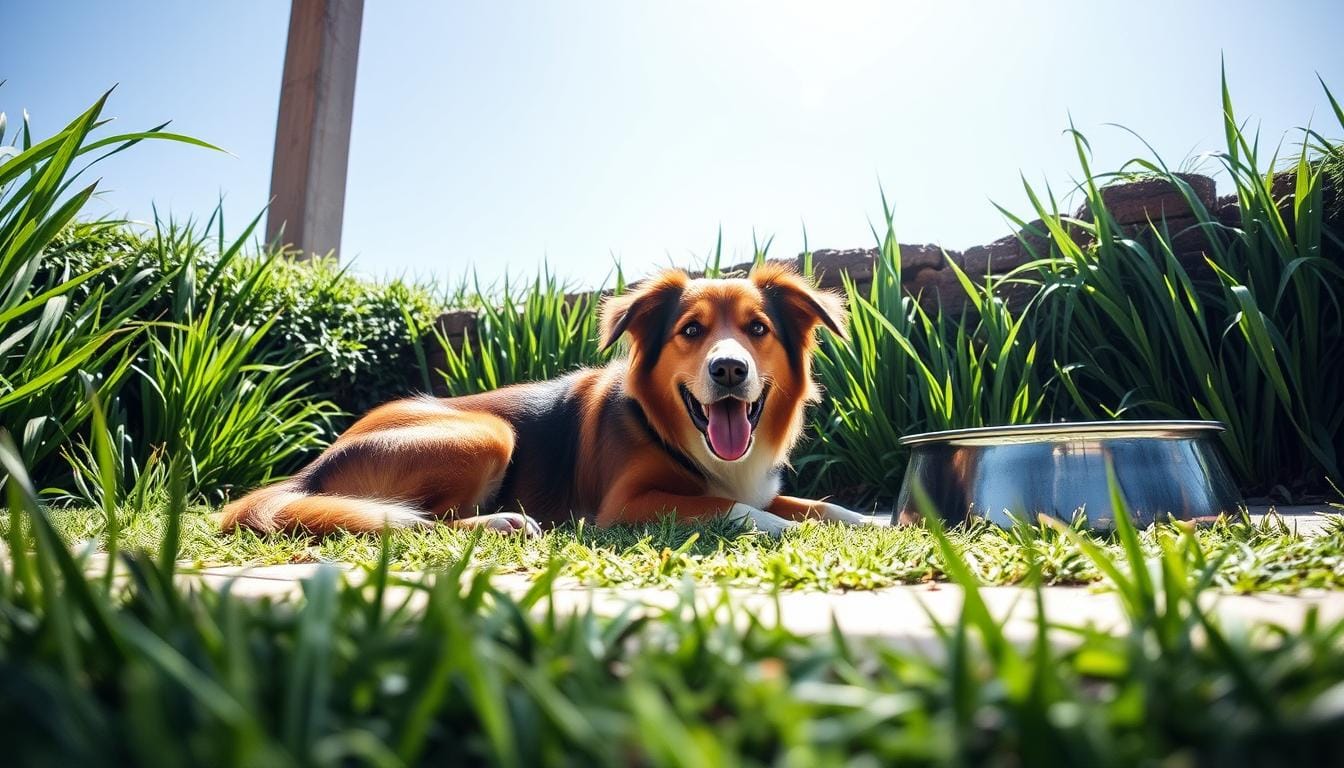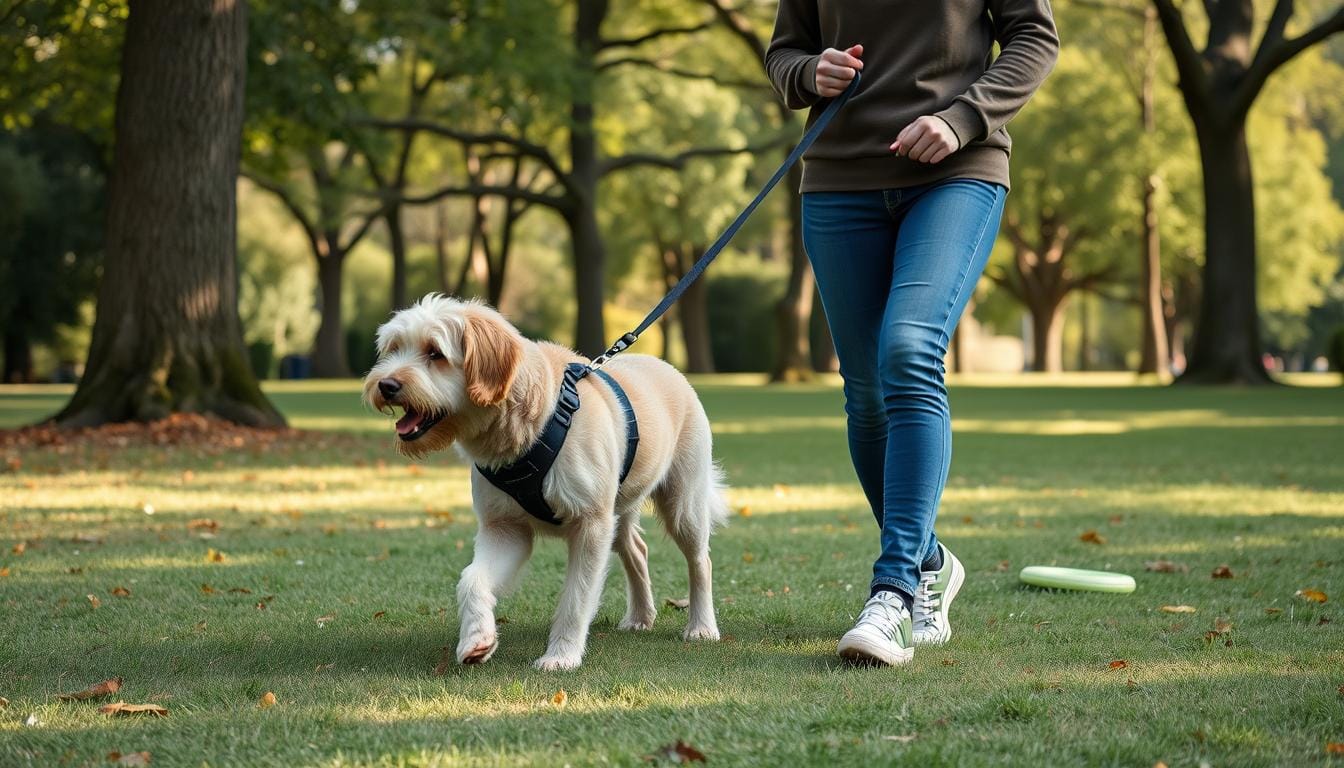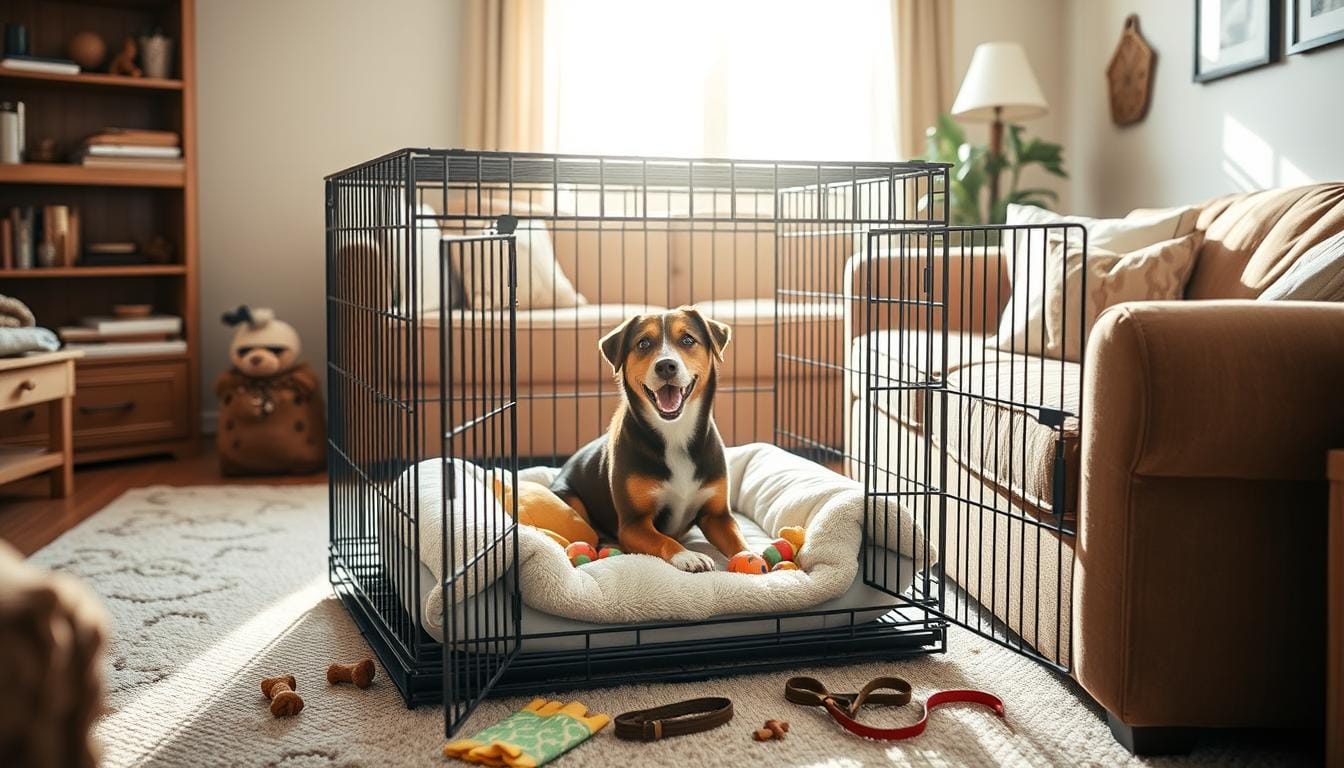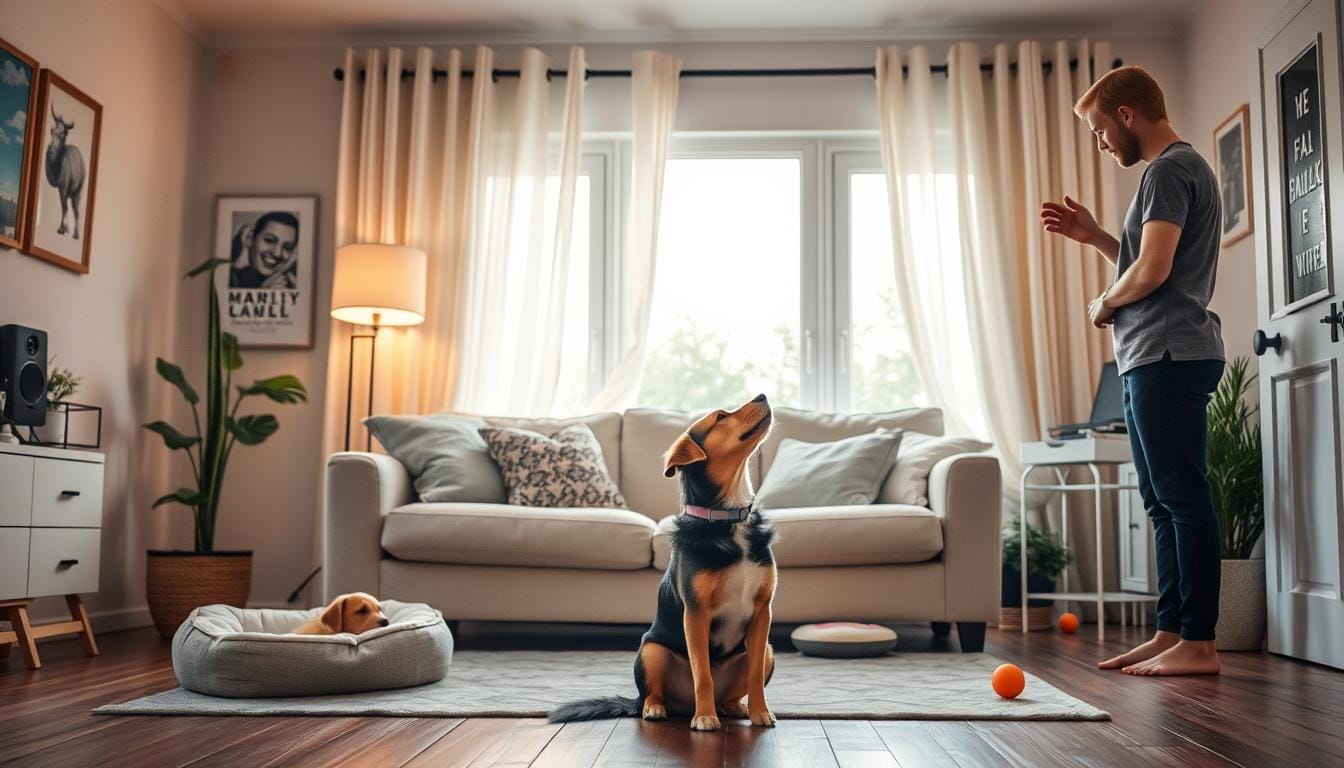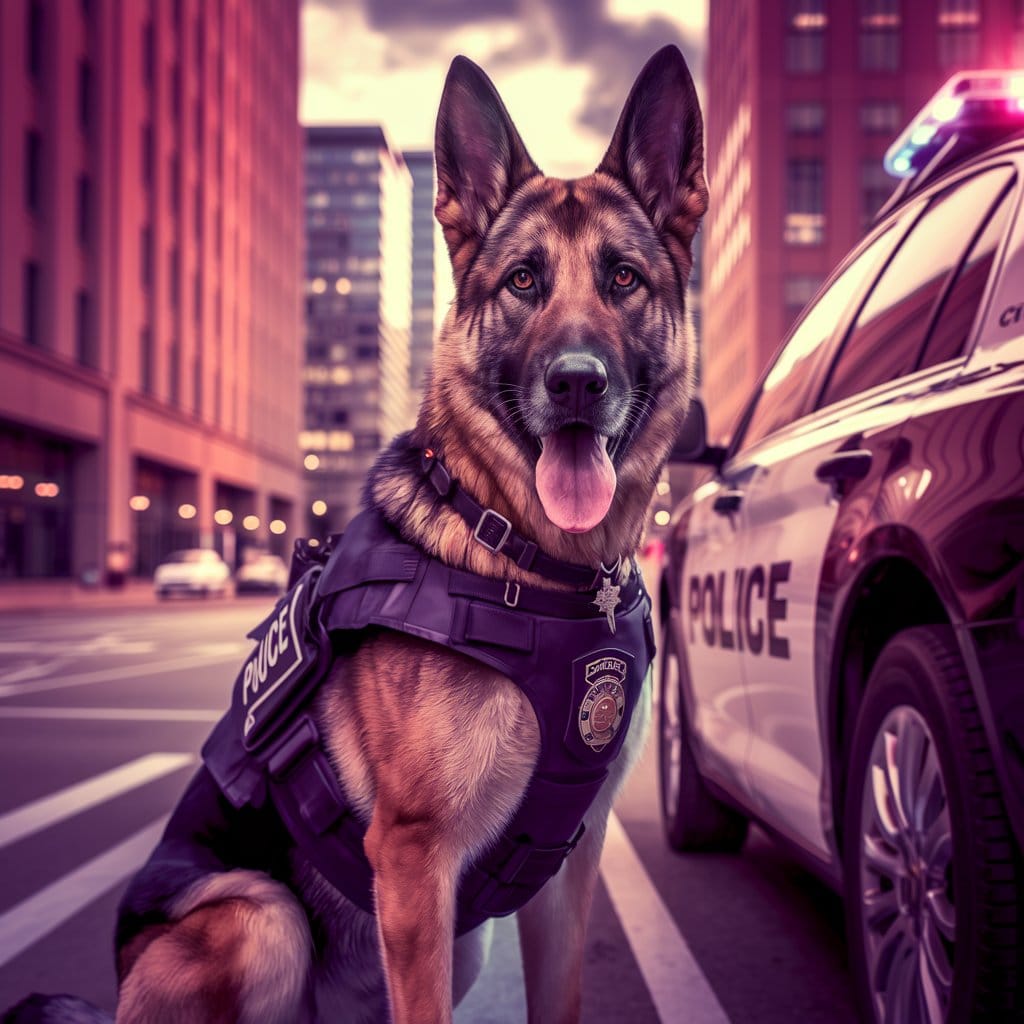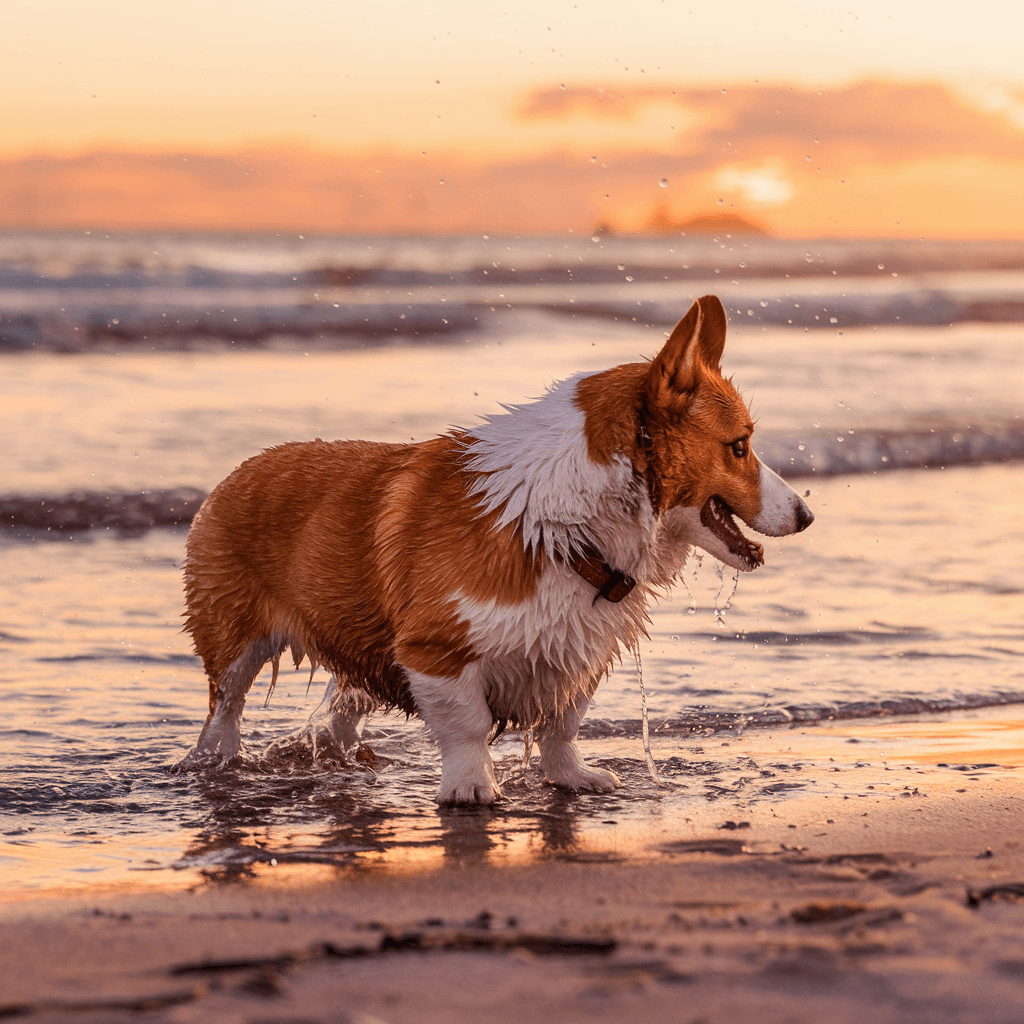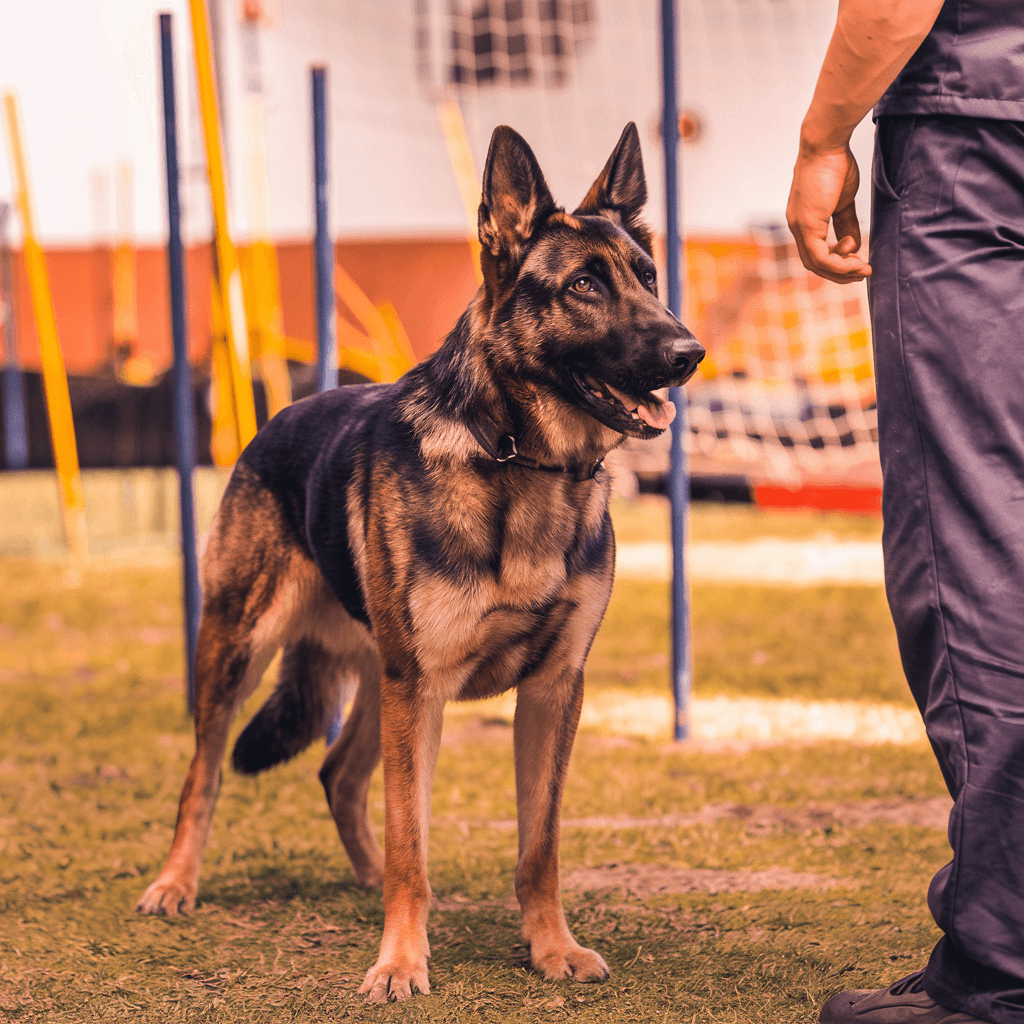Summer is here, and our furry friends need extra care. Dogs can’t handle heat as well as humans. We’ll share some easy tips for keeping them safe and cool.
Dogs can’t sweat like we do. They cool down by panting and through their paw pads. This makes them more vulnerable to heat, especially for breeds with flat faces or thick coats.
Protecting dogs from heat is key. A car can get too hot for them in minutes. Temperatures inside can reach deadly levels.
Keeping dogs cool is about more than comfort. It’s about their safety. Signs of overheating include panting, drooling, weakness, and even seizures. If you see these signs, act fast to cool them down.
Key Takeaways
- Dogs can’t regulate body heat as efficiently as humans
- Car interiors can reach dangerous temperatures quickly
- Some breeds are more heat-sensitive than others
- Never leave dogs in parked cars
- Know the signs of overheating in dogs
- Provide constant access to fresh water and shade
- Adjust exercise routines during hot weather
Understanding Heat Sensitivity in Dogs
Dogs have special ways to keep cool, but they can still get too hot. Let’s look at how they handle heat and which breeds need extra care in summer.
How Dogs Regulate Body Temperature
Dogs can’t sweat like humans do. They mainly cool down by panting. They also lose heat through their paw pads. If these methods fail, their body temperature can quickly rise, posing health risks.
Breeds Most Susceptible to Heat
Some dog breeds find it harder to stay cool than others. Breeds like boxers, pugs, and shih tzus have trouble breathing in the heat. Large dogs and those with thick coats also face higher risks. Dogs with white or light fur are more likely to get sunburned, while dark-coated dogs absorb more heat.
Normal vs. Dangerous Body Temperatures
A healthy dog’s temperature is usually between 101 and 102.5°F. It’s very important to watch the temperature of heat-sensitive breeds closely. If a dog’s temperature goes over 103°F, you need to act fast.
| Temperature (°F) | Condition | Action Required |
|---|---|---|
| 101 – 102.5 | Normal | Regular monitoring |
| 102.5 – 103 | Mild fever | Close observation |
| 103 – 104 | Fever | Cooling measures needed |
| Above 104 | Heatstroke risk | Immediate veterinary care |
Prevention is the best way to keep your dog safe. Make sure they stay cool, give them lots of water, and never leave them in a hot car. Knowing how your dog handles heat helps keep them safe and happy all summer.
Essential Summer Safety Equipment for Dogs
Summer heat can be tough on our furry friends. We’ve gathered a list of must-have dog cooling products and summer pet gear. These items will keep your canine companion safe and comfortable during hot days.
Cooling Vests and Mats
Cooling vests are a game-changer for canine heat protection. These innovative garments can be soaked in water and worn by your dog. They provide instant relief from the heat. Cooling mats offer a refreshing spot for your pup to relax, drawing heat away from their body as they rest.

Protective Gear and Accessories
Safeguard your dog’s sensitive paw pads with protective booties. These shield their feet from hot pavements, which can reach dangerous temperatures quickly. Don’t forget about sunscreen specially formulated for dogs, especially if your pet has light-colored or thin fur.
Hydration Tools and Equipment
Proper hydration is crucial in hot weather. Invest in collapsible water bowls and doggie water bottles for on-the-go hydration. These portable solutions ensure your pup always has access to fresh water during outdoor adventures.
| Summer Pet Gear | Benefits |
|---|---|
| Cooling Vest | Provides instant relief from heat |
| Protective Booties | Protects paws from hot surfaces |
| Portable Water Bottle | Ensures hydration on-the-go |
Remember, these dog cooling products are essential for summer safety. But they’re not substitutes for proper care and attention. Always monitor your pet for signs of overheating and provide plenty of shade and water during hot weather.
Dog safety, hot weather tips, cooling dogs, summer pet care
Summer brings unique challenges for our furry friends. We need to be extra vigilant about indoor dog cooling, outdoor pet safety, and heat emergency prevention. Let’s explore some key strategies to keep our dogs safe and comfortable during the hot months.
Indoor Cooling Strategies
Keeping your dog cool indoors is crucial. Use air conditioning or fans to maintain a comfortable temperature. Provide cool surfaces like tile floors for your dog to lie on. Create a designated cool room or use the basement as a retreat during peak heat hours.
Outdoor Activity Management
When it comes to outdoor pet safety, timing is everything. Walk your dog during cooler parts of the day, such as early morning or late evening. Limit exercise duration and intensity. Always provide access to shade and fresh water. Be cautious of hot pavements that can burn paw pads.
Emergency Prevention Measures
Heat emergency prevention starts with awareness. Monitor your dog’s temperature and watch for signs of overheating like excessive panting or dark red gums. Keep cooling supplies readily available. Remember, pets with short muzzles are more prone to heatstroke.
| Temperature | Risk Level | Recommended Action |
|---|---|---|
| Up to 80°F (26.7°C) | Low | Normal outdoor activities |
| 80-90°F (26.7-32.2°C) | Moderate | Limit activity, provide shade and water |
| Above 90°F (32.2°C) | High | Minimal outdoor exposure, focus on indoor cooling |
By implementing these strategies, we can ensure our dogs stay safe and comfortable during the hot summer months. Remember, prevention is key in avoiding heat-related emergencies.
Water and Hydration Management
Keeping our dogs hydrated is key to avoiding dehydration, especially in the summer. Make sure to have water available both inside and outside. This helps meet their water needs during the hot months.
It’s a good idea to give your dog about 1 ounce of water for every pound of their body weight each day. In the heat, they might need even more. Always keep their water bowls full and fresh throughout the day.
To get your dog to drink more, try adding ice cubes to their water. This makes the water cooler and adds a fun twist. You can also give them frozen treats like pupsicles for extra hydration and coolness.
When you’re outside with your dog, carry water and a portable bowl. This way, you can give them water breaks during walks or playtime. It’s important to keep them hydrated in the heat.
“Provide access to clean and stable water sources at all times to ensure proper hydration for pets during hot weather.”
Keep an eye on how much water your dog is drinking. Look out for signs of dehydration like dry gums, sunken eyes, and lethargy. If you see these signs, call your vet right away.
| Item | Price | Benefits |
|---|---|---|
| Pet Water Bottle | $14.99 | Portable hydration for walks and outings |
| Cooling Water Bowl | $28.19 | Keeps water cool for longer periods |
| Chilling Bandana | $9.48 | Helps cool neck area while providing hydration |
Safe Exercise and Walking Guidelines
Summer dog walks need careful planning to keep pets safe in the heat. We’ve gathered key tips to ensure your furry friend stays healthy and happy during warm-weather activities.
Best Times for Walks
Plan summer dog walks for cooler times of the day. Early mornings or evenings are best. This helps avoid overheating and makes walks more fun.
Pavement Temperature Safety
Hot pavement can hurt your dog’s paws. Check the pavement temperature before walking. If it’s too hot for your hand, it’s too hot for your pet. Here are some temperature guidelines:
| Air Temperature | Concrete Temperature | Asphalt Temperature |
|---|---|---|
| 85°F | 105°F | 130°F |
| 97°F | 145°F | 150°F |
Exercise Duration and Intensity
Adjust your dog’s exercise to the heat. Shorten walks and reduce intensity when it’s hot. Indoor play or water activities are good alternatives. Dogs feel heat more than humans, so watch them closely outside.
By following these tips, you can have fun summer activities with your dog while keeping them safe. Always provide fresh water and look for signs of heat stress during walks.
Creating Cool Spaces at Home
When summer heat hits, it’s key to make dog-friendly cooling areas at home. Keeping dogs cool is vital to avoid heatstroke and hyperthermia. Let’s look at ways to manage indoor temperatures and create pet comfort zones.

Begin by setting up shaded spots inside and outside. Use cooling mats or damp towels for your dog to relax on. These mats can cool your pet for up to three hours, thanks to their weight.
Install fans or air conditioning in your dog’s favorite spots. This keeps them cool and comfortable.
For outdoor cooling, think about a kiddie pool. Close curtains during the day to block heat. Make sure your dog has access to cooler rooms like basements. Avoid hot spots like conservatories or direct sunlight. Use elevated beds for better air flow.
“A dog’s comfort is paramount in hot weather. Creating cool spaces at home can significantly reduce their risk of overheating.”
Dogs don’t sweat like humans. They cool down by panting and losing heat through their paw pads. This makes them more prone to overheating, especially when it’s over 77°F.
| Temperature (°F) | Risk Level for Dogs | Recommended Action |
|---|---|---|
| Up to 68°F | Safe | Regular walks and outdoor activities |
| 68°F – 77°F | Moderate | Shorter walks, provide shade and water |
| Above 77°F | High | Limit outdoor time, focus on indoor cooling |
By using these tips, we can keep our dogs cool and comfy during summer’s hottest days.
Recognizing Signs of Heatstroke
It’s key for pet owners to know the signs of dog heatstroke. Heat exhaustion in dogs can get worse fast. So, it’s important to spot the signs early and act quickly.
Early Warning Signals
Dogs usually keep cool by panting and expanding their blood vessels. But, when these methods don’t work, you’ll see signs of heat stress:
- Heavy panting
- Rapid breathing
- Excessive drooling
- Bright red gums and tongue
- Increased heart rate
Emergency Symptoms
As heat exhaustion gets worse, more serious symptoms show up:
- Vomiting or diarrhea
- Disorientation or stumbling
- Collapse or loss of consciousness
- Body temperature above 105°F (40.5°C)
When to Contact a Veterinarian
If you think your dog has heatstroke, call a vet right away. While waiting, get your dog to a cool spot, give them water, and use cool water on their body. Remember, heatstroke can be deadly, with a nearly 50% fatality rate.
| Normal Temperature | Heatstroke Threshold | Critical Temperature |
|---|---|---|
| 99°F – 102.5°F | 103°F | Above 105°F |
By spotting these signs early and acting fast, we can save our pets from heatstroke.
Summer Grooming and Coat Care
Summer brings unique challenges for our furry friends. Seasonal dog grooming is key to keeping them comfortable and healthy. Let’s explore some essential coat management tips for the warmer months.
Regular brushing is key to effective summer fur care. It removes excess hair, prevents matting, and helps dogs stay cool. For long-coated breeds, consider a trim to lighten their coat. But avoid shaving completely as it can lead to sunburn.
Bathing your dog helps maintain a clean, healthy coat. Use lukewarm water and dog-specific shampoo to avoid skin irritation. Don’t forget to pay attention to their paw pads, trimming excess fur between them to reduce heat retention.
“A well-groomed coat acts as natural insulation, protecting your dog from both heat and sunburn,” says Dr. Emily Carter, a veterinary dermatologist.
For light-colored or short-haired breeds, apply dog-safe sunscreen to exposed areas like the nose and ears. This extra step in your coat management routine protects against harmful UV rays.
| Grooming Practice | Percentage of Dog Owners |
|---|---|
| Consider grooming essential for summer comfort | 79% |
| Long-coated breed owners opting for summer trims | 68% |
| Short-coated breed owners opting for summer trims | 31% |
Remember, proper grooming is just one aspect of summer pet care. Always provide plenty of fresh water and shade during outdoor activities. This keeps your furry friend safe and comfortable in the heat.
Conclusion
As we finish our summer dog care summary, it’s clear that keeping dogs safe in the heat is key. We’ve looked at ways to keep our furry friends cool and comfy. This includes understanding how dogs cool down and knowing the signs of heatstroke.
Dogs don’t sweat like we do. They cool down by panting and have sweat glands in their paw pads. This makes them more likely to overheat, especially if they have thick fur or flat faces. Puppies, senior dogs, and those with health issues are at higher risk.
It’s our job to watch for signs of distress. Look for excessive panting, unusual quietness, or bright red gums. Our heat safety recap includes important tips. Provide constant fresh water, create cool spaces, and limit outdoor activities during peak heat hours.
We’ve also talked about cooling products like vests and mats. Regular grooming is also crucial. Always check pavement temperature before walks and never leave pets in cars. By following these tips and staying alert, we can ensure our dogs have a safe and comfortable summer.

